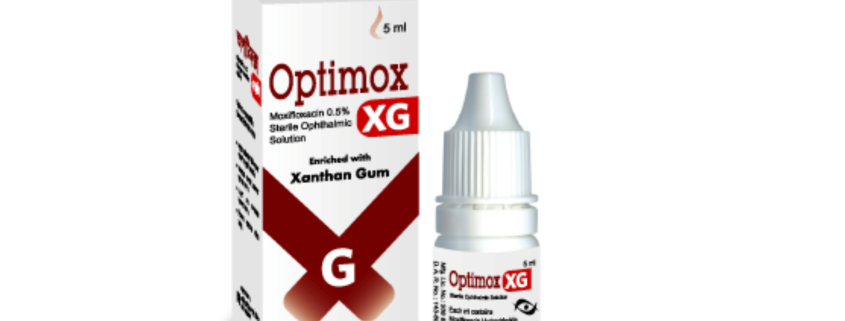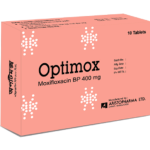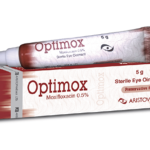Optimox XG (Moxifloxacin (enriched with Xanthan Gum)

Therapeutic Group : Antibiotic
Presentation:
Optimox® XG Ophthalmic Solution: Each ml contains Moxifloxacin Hydrochloride BP equivalent to Moxifloxacin 5 mg (enriched with Xanthan Gum BP 0.4%).
Pharmacology:
Olopatadine selectively blocks histamine H1 receptor and stabilizes mast cells. Thus, it prevents histamine binding to its receptors and inhibits mast cell degranulation & histamine release.
Indications:
Optimox® XG is indicated for the treatment of bacterial conjunctivitis caused by susceptible strains of following organisms: Aerobic Gram-positive microorganisms: Corynebacterium species, Micrococcus luteus, Staphylococcus aureus, Staphylococcus epidermidis, Staphylococcus haemolyticus, Staphylococcus hominis, Staphylococcus warneri, Streptococcus pneumoniae, Streptococcus viridans group. Aerobic Gram-negative microorganisms: Acinetobacter iwoffii, Haemophilus influenzae, Haemophilus parainfluenzae.
Dosage & Administration:
One drop in the affected eye(s) 2 times daily for 7 days.
Warning & Precautions:
Prolonged use may result in overgrowth of non-susceptible organisms, including fungi like with other anti-infectives.
Use in Pregnancy:
Moxifloxacin should be used during pregnancy only if the potential benefit justifies the potential risk to the fetus as there are no adequate and well-documented studies in pregnant women.
Use in Lactating Mother:
Moxifloxacin has not been measured in human milk, although it can be presumed to be excreted in human milk. Caution should be exercised when Moxifloxacin is administered to a lactating mother.
Pediatric Use:
The safety and effectiveness of Moxifloxacin in infants below four months of age was not proven. However, several clinical studies show that the drug may be used safely in children even younger than one month of age.
Geriatric Use:
No overall differences in safety and effectiveness have been observed between elderly and younger patients.
Side effects:
The most frequently reported ocular side effects are ocular discomfort, irritation etc. may occur.
Drug interaction:
Drug-drug interaction studies have not been conducted with Moxifloxacin Hydrochloride. In vitro studies
indicate that Moxifloxacin does not inhibit CYP3A4, CYP2D6, CYP2C9, CYP2C19 or CYP1A2 indicating that Moxifloxacin is unlikely to alter the pharmacokinetics of drugs metabolized by these cytochrome P450 isoenzymes.
Use in special groups:
Use in Pregnancy:
Moxifloxacin should be used during pregnancy only if the potential benefit justifies the potential risk to the fetus as there are no adequate and well-documented studies in pregnant women.
Use in Lactating Mother:
Moxifloxacin has not been measured in human milk, although it can be presumed to be excreted in human milk. Caution should be exercised when Moxifloxacin is administered to a lactating mother.
Pediatric Use:
The safety and effectiveness of Moxifloxacin in infants below four months of age was not proven. However, several clinical studies show that the drug may be used safely in children even younger than one month of age.
Geriatric Use:
No overall differences in safety and effectiveness have been observed between elderly and younger patients.
Packing:
Optimox® XG Ophthalmic Solution: Each LDPE dropper bottle contains 5 ml Sterile & Pyrogen free
Ophthalmic Solution.
Therapeutic Group : Antibiotic



